|
|
TOURISM - SCOTLAND CENTRAL |
CITY OF STIRLING |
Stirling has more history than any other royal burgh. It dates back at least to the fifth century; it was originally built of wood. It has been torched and burnt to the ground on three occasions – firstly in March 1244; again, in 1298; and, later still, in 1385. Stirling became an important settlement because it is the lowest crossing place over the River Forth. Furthermore it has a rocky outcrop, which was a natural place to build a fort. (The name Stirling is derived from Striveling, meaning place of strife). |
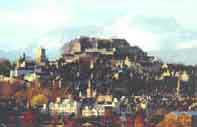 |
By the 11th century a royal castle was built on the crag. Around the year 1115 king Alexander 1 had a chapel dedicated within his castle at Stirling . He also died at Stirling Castle in 1124, from where he was taken to Dunfermline Abbey for burial alongside his mother Queen Margaret. From then on, a continuous succession of Scottish kings used Stirling Castle as one of their most important administrative strongholds. At a time when there was no permanent capital in the country - the 'capital' was wherever the king held his parliament - a remarkable number of royal acts were issued from Stirling . Sometime in the 1120's the king (Alexander I) made it into a town by granting the townspeople a charter. (A charter was a document, which gave them certain rights). |
In 1124 king David 1 made Stirling one of the first ‘Royal Burghs' in Scotland, granting special favours, which allowed it to develop into an important medieval trading town. The Royal Burgh had its own local government. The merchants of Stirling elected a provost to run the town. The small town flourished and by the ‘Middle Ages' it had a Tryst and market on a weekly basis. In 1140 the same king David also founded nearby Carnbuskenneth Abbey, an Augustinian house similar to Holyrood Abbey that he also established close to his residence at Edinburgh Castle . Clearly Stirling and Edinburgh were now emerging as the two most favoured royal residences in Scotland . The town of Stirling was well known as a wool producing area, and even small ships could utilise the port from the Forth . Cambuskenneth Abbey was founded in the year of 1145. It was an Augustinian abbey, and was built on the other side of the River Forth from Stirling by King David I. |
Religion was prominent in Stirling mainly through the ‘Friars' both black and grey. They were named because of the colouring of their robes. The originally castle was built in wood but in the late 13th century it was rebuilt in stone. William I gained his freedom from the English in the year 1174 by giving them the castle. He had been captured during a battle. The castle was to change hands several times over the next few years. After the battle of Stirling Bridge with the Scottish leader Sir William Wallace defeating the English, the castle was once more in Scottish control. It was then lost again when Wallace was defeated at Falkirk . |
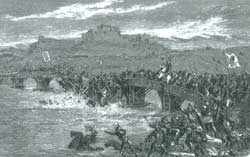 |
When Sir William Wallace retreated north, English forces once more occupied the castle. It changed hands again in 1299 when the Scots recaptured it. Back it went to the English in the year 1304, but the Scots recaptured it in 1314 after the battle of Bannockburn . FOR MORE INFORMATION ON THESE BATTLES SEE WILLIAM WALLACE AND KING ROBERT THE BRUCE IN THE HISTORY SECTION |
Despite not being able to see it in the film ‘Braveheart' Stirling had a wooden bridge spanning the river. A new one was built in the year 1415, this time from stone. Stirling continued to prosper as a good market town. The royal residence was always busy and in the 17 th century it was estimated to be in excess of 1,500 people. The undoing of the town as a major centre started when James VI of Scotland first of England took control of the two countries. He moved everything to London and operated the countries from there. Stirling became little more than a garrison. Mary Stuart was crowned as Queen of Scots in the Royal Chapel at Stirling Castle on September 9 1543. Due to the age of the Queen (she was less than one year old) and the unique ceremony, the coronation was the talk of Europe . The Battle of Pinkie and the year 1547 saw Stirling build large stonewalls round the town. In the latter half of the 16th Century Anti Catholic sentiment was running high in the town. Four Catholic priests being publicly humiliated in the Mercat Cross. Not only were they chained up but also pelted with dung by an angry mob. John Knox was living out his dream of creating a Protestant Scotland. He preached hellfire and damnation to Queen Mary of Scotland , and also to Bloody Mary, queen of England . In 1608 the town council decided to ban beer from being sold after 10pm. They thought it was interfering too much in the everyday life of the town. People could not work in the morning because of drinking to late the night before. They are quoted as saying ; 'under cloude of nicht, drinking and playing in other menis and disabusing thame selfis to the offence of God and evil exemple of nychtbouris [neighbours]'. Stirling was typical of many small towns of that era. It was both dirty and unsanitary. Outbreaks of plague were at that time quite common in the country as a whole, with epidemics in 1606 and 1645. The 1606 outbreak killed over 600 people, which at the time, was a large part of the town's population. The 1645 visitation of the plague, left Stirling very under populated. In the years 1639 - 49 John Cowane, a wealthy Stirling merchant bequeathed funds to build a place, originally offering charity to unsuccessful merchants or 'gildbreithers' and later used as a school and epidemic hospital. Originally there were two storeys until the main part of the building was altered in 1852 to form a Guildhall with balcony, gallery and elongated windows in the main hall. The statue of John Cowane above the doorway is known as Staneybreeks and there is a rumour that every Hogmanay, he gets down for a dance. |
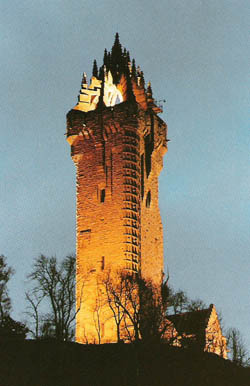 |
Fortunately Stirling escaped any damage in the Jacobite risings of 1715 and 1745. On his march south during the ‘45' Prince Charles Edward Stuart (Bonnie Prince Charlie) as he crossed the Highland Line came close to Stirling . The Town Council fearing what was to come thought the might save the town by surrendering peacefully. The castle, however, held out until Charles returned north. His troops attempted to climb the Castle rock from the north side, but were unsuccessful. His men blew up the medieval parish of St Ninians while the Governor of the Castle destroyed an arch of Stirling Bridge to impede the Jacobite troops.
SEE THE HISTORY SECTION ON CULLODEN FOR MORE INFORMATION OF THE JACOBITE UPRISING
On the 26th August 1787, Robert Burns the famous Scottish Bard paid a visit to the town. He was travelling to Inverness , for a meeting. He really liked the town and that night decided to pen some words on the window of his room: |
They are as follows "Here Stewarts once in triumph reigned, And laws for Scotland 's weal ordained; But now unroofed their palace stands, Their sceptre's swayed by other hands; Fallen, indeed, and to the earth Whence grovelling reptiles take their birth, The injured Stewart line is gone. A race outlandish fills their throne; An idiot race, to honour lost; Who knows them best despise them most." |
This was not to be Robert Burns last visit to Stirling , he came back in October of that year. At the end of the 18th century the industrial revolution began to transform Scotland , but this new age of industry largely by-passed the town. However the traditional wool weaving industry continued. There was also a carpet weaving industry. Some cotton was also woven in Stirling , and the first bank in opened in the year of 1777. Stirling moved into the new 19 Th century with hope in her heart. Business was picking up and new companies being formed. Wilsons was one of these companies and they brought work to the Stirling area. Many books on Tartan and the kilt suggest that these are the actual patterns worn by the Scottish clans throughout history up to, and including, the Battle of Culloden in 1746. However this is not the case. The majority of the pre-1850 patterns bearing clan names can only be traced back to the early 19th century and to the famous weaving firm of William Wilson & Sons of Bannockburn , near Stirling . |
William Wilson started his family business south of the Highland boundary in Bannockburn on the outskirts of Stirling where, being unaffected by the Act, he was able to flourish. He quickly cornered the growing market for tartan in southern Scotland and elsewhere, and especially for the lucrative supply of cloth to the military and the increasing number of Highland Regiments. The need for mass cloth production to meet large orders such as the military, led to a requirement for standard colours and patterns in order to maintain quality control. These standardised colours and patterns devised by Wilsons were certainly in use by them by the 1780's and their range continued to grow with the increase in the demand for tartan; a trend which continued throughout the 19th century. By the time the first aniline dye was introduced in 1856 the use of standard colours and colour terminology had been practised by Wilsons for over seventy years and was firmly established. Wilsons started to name some of their patterns after towns and districts in the latter half of the 18th century. Towards the end of the century the use of family names for tartans becomes apparent and this practice increased over the next fifty years and in 1819 they complied their in house reference manual the 1819 Key Pattern Book. |
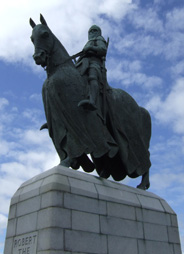 |
The first census in 1801 showed Stirling had a population of 5,271. By the standards of the time it was a fair sized market town. By 1821 the population had grown to 7,333, and was increasing all the time The north of the old town was to witness the birth of new streets. Cowane Street, Irvine Place and Queen Street . Stirling gained gas street lighting in 1826 and in 1833 a new bridge was built. A serious outbreak of cholera in 1832 had the whole town in a panic, but good was to come from this potentially fatal malady. Sewers were dug under the streets in the 1850s, which went a long way to making the town a nicer and healthier place to live. In 1840 Stirling was linked up to the Caledonian rail network. This line was very long and ran through southern Scotland . From Carlisle to Motherwell the line carried the travellers quicker than ever before. There was a branch to Edinburgh and a further line between the north of Coatbridge and near Larbert which connected the line to other lines running to Stirling, Perth , Dundee and Aberdeen .
|
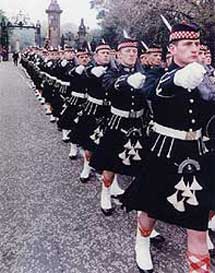 |
The line between Stirling and Dunfermline is now closed, however track remains in place between Stirling and Alloa. This railway is due to be re-opened in 2007 between Stirling and Alloa for passengers and between Stirling and Kincardine Junction (and on to Kincardine) for freight. The north end of The King's Own Building was destroyed by fire in 1855. The damage was so bad that it had to be rebuilt, with a new front footage. By then the explosives and ammunition storage area placed in the Douglas Garden in 1681 (and still there) had been made redundant by others more safely located in the Nether Bailey. The regimental museum of the Argyll and Sutherland Highlanders is now situated at The King's Own Building . There have been calls from time to time that the building should be restored as has happened with the Chapel Royal and Great Hall. However, so much uncertainty exists about what it was like when built that this seems very unlikely. |
In 1857 Stirling gained its first modern police force, with a jail sited in the old town. The Wallace Monument , a tribute to Scotland 's famous hero and martyr was built in 1869. In the year of 1871 Stirling had a population of 11,788. By 1881 the figures had risen to 14,000. An infirmary was built in Stirling in 1874. Also in 1874 horse drawn trams began running through the streets of Stirling . The Smith Art Gallery and Museum also opened in 1874, this building will hopefully receive and display the coffin used in the ‘Walk For Wallace, in 2005 by the Scottish patriot and novelist David Robertson Ross. The Old Arcade was built in 1882. Furthermore the Mercat Cross was restored in 1891. New housing was being built west of the old town at Abercromby Place , Clarendon Place , Victoria Place, Victoria Square and Queens Road . These houses were for the better off Scottish citizens and many of them used the rail link to commute to Glasgow and Edinburgh. New streets were also built north of the old town such as Wallace Street , Bruce Street , Douglas Street and Union Street . The twentieth Century saw Stirling making huge changes to the town. The population had grown to over 18,000 Andrew Carnegie, the Scottish steel baron, laid the foundation stone of the Public Library in the Corn Exchange. He donated toward the building costs as he did with many others both in Scotland and in his adopted homeland in the United States . A plaque commemorates Carnegie's visit to Stirling in 1902, when Andrew Carnegie received a ceremonial freedom of the burgh. The plaque reads "This memorial stone was laid on 11th October 1902, by Mrs Carnegie, wife of Andrew Carnegie Esq. LL.D, of Skibo, the donor of this building." Carnegie attended many such ceremonies when he was living at his Scottish home at Skibo. In the year 1928, a new political party was formed; this event took place in King's Park. The meeting resolved to work for the political independence of Scotland . The 2000 strong crowd celebrated the birth of the new party at none other than Bannockburn , the scene of Robert The Bruce's famous victory. Members of the Scottish National League, including the Gaelic nationalist and writer R. S. Erskine Mar and poet C. M. Grieve (Hugh MacDiarmid), had been founding members. The NPS had been founded in Stirling by The NPS had soon attracted left-wingers from the Scottish Home Rule Association (SHRA, 1886-1929) which had emerged during the period of Gladstone's adoption of the Irish cause and when Liberals had taken up the idea of home rule for Scotland, Ireland, and Wales However the party faired badly in the1929 elections, maybe due to Scotland 's mistrust of things new. In 1931 the writer and nationalist Compton Mackenzie was elected Rector of Glasgow University. During the economic crisis of the 1930s, conservatives from the Scottish Party merged with the NPS - purged of its extremists including C. M. Grieve - and the Scottish National Party was born in 1932. The council of Stirling began slum clearance In the 1920s and 1930s and built council houses to replace the slums at Raploch and the Riverside . In the 1950s and 1960s, many more council houses were built. Stirling University , first opened its doors in 1967, and is situation on a fine 18th century estate in the shadow of the Ochil Hills. Since the birth of the University, it has shown a maturity far beyond its years, establishing a fine record for academic excellence, topping UK tables for its research achievements, and carving out for itself a truly international reputation. Among its 7,500 students no less than 75 countries are represented. The university's departments amply reflect the fact that as well as its important dimension on the UK scene, the institution is playing a true international role. Its highly rated Scottish Centre for Japanese Studies, which prepares graduates for in international business and communication, has promoted a greater understanding of Far East ways, and imparted some of the knowledge that has made Japan a world economic power. During the 20th century Stirling was still a market town rather than an industrial centre but there were some industries such as financial services, food processing and electronics. Castle Business Park opened in 1995. Stirling 's Tollbooth was one of the most exciting commission programmes has now been completed. Linked to the building redevelopment as a music and performing arts venue, artists and designers were commissioned to create new work. Reflecting the building's important place in Stirling and Scotland 's history. One of the main aims of the attraction is to discover what life was like behind bars 150 years ago. It also provides visitors with a vivid insight into the gruesome job of the town hangman, Jock Rankin. In 2002 Stirling was granted ‘City' status. The main reasons for this status was the world-class university spread across one of the most beautiful campuses in Europe . There was also the largest regeneration project in the country, a new national park on the doorstep, thriving inward investment, a growing population and a great quality of life are just some of the reasons for Stirling 's success story. Stirling is also home to the internationally known entertainer Ted Christopher, who had a number one chart success with ‘Knock, Knock, Knocking on Heavens Door' in aid of the ‘Dunblane Massacre charities'. (SEE MUSIC SECTION FOR MORE INFORMATION) |
|
